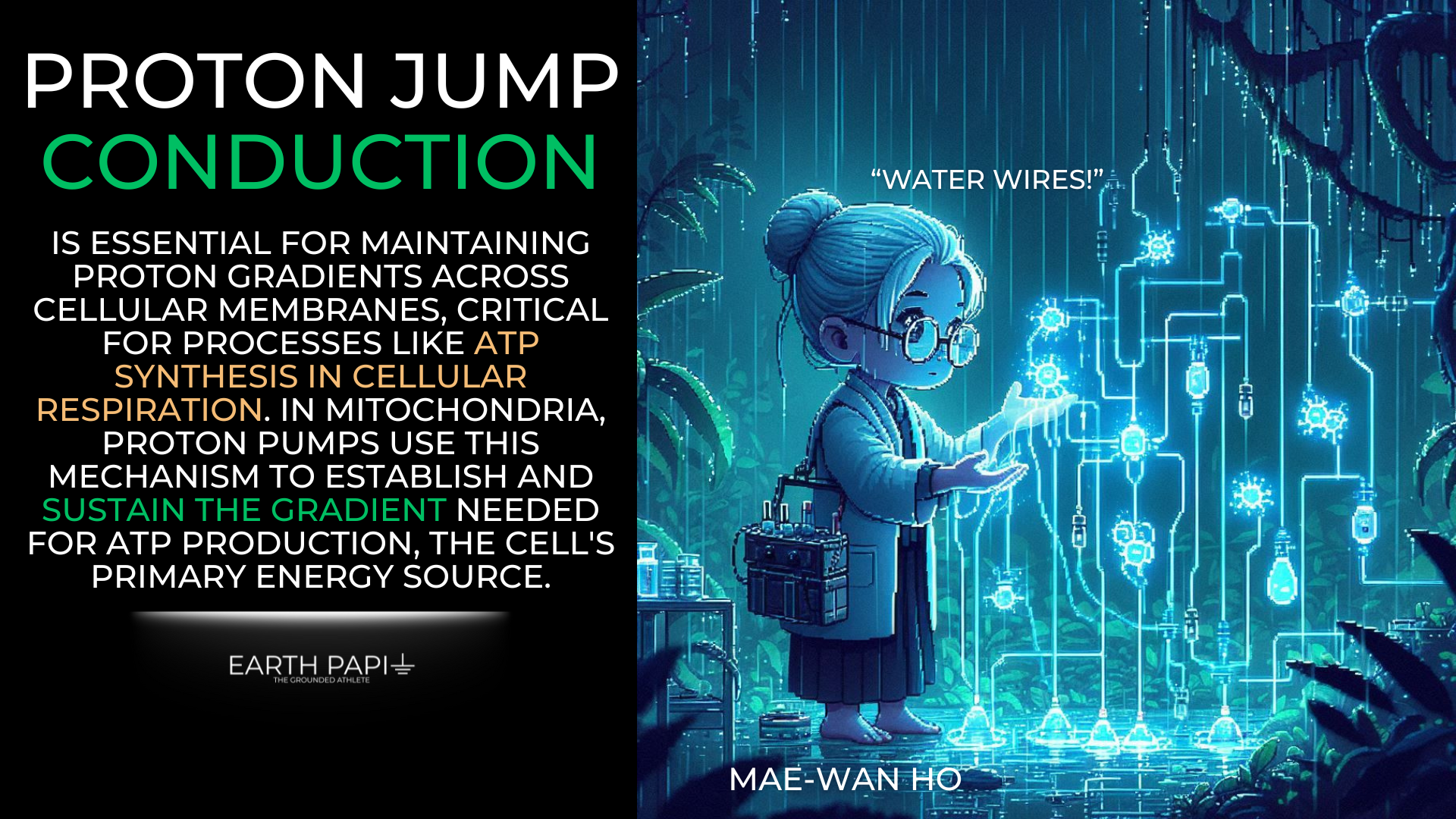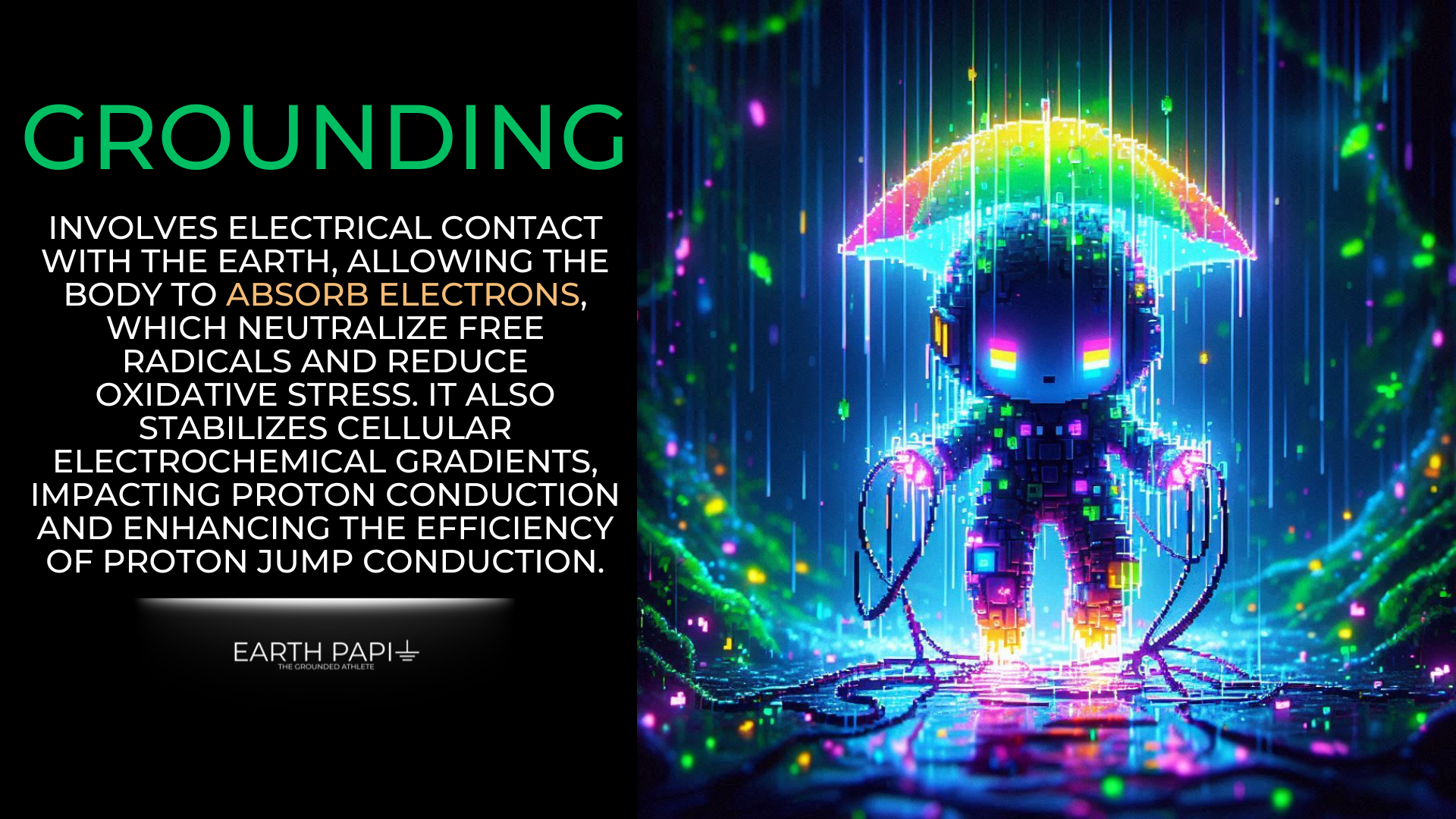What is Proton Jump Conduction, Why is it Relevant to Biology, and Why Grounding is Important in Maintaining the Gradient
Understanding Proton Jump Conduction
In Mae-Wan Ho’s books, she discusses Proton jump conduction, also known as proton hopping, which is a process where protons are transferred rapidly across networks of hydrogen-bonded molecules. This type of conduction involves the movement of protons through a chain of water molecules connected by hydrogen bonds, enabling a proton to move without a full physical relocation across the entire distance. Instead, a proton at one end of the chain can be effectively relayed through the bond network, creating a swift and efficient form of charge transport.
The mechanism involves hydronium ions (H₃O⁺) formed when protons bind to water molecules. These ions engage in proton exchange with neighboring water molecules along the hydrogen-bond network. This allows the proton to "jump" from one water molecule to another in a rapid relay. Such a process is faster than conventional ionic diffusion and plays an essential role in various biochemical systems.
Biological Relevance of Proton Jump Conduction
Proton jump conduction is crucial for maintaining proton gradients across cellular membranes, which are foundational to numerous biological processes. These gradients are particularly significant in cellular respiration, where they drive ATP synthesis, the primary energy currency of the cell. The process of ATP production depends on the movement of protons across the mitochondrial membrane, which is facilitated by proton pumps that leverage proton jump conduction to create and maintain the gradient.
Water molecules within cellular structures, especially in confined spaces, exhibit behaviors that enhance proton jump conduction. For instance, the organization of water molecules around proteins and membranes creates structured pathways conducive to rapid proton transfer. This structural arrangement of water is often referred to as structured water, a form that possesses unique properties compared to bulk water.
Role of Structured Water
Structured water differs from ordinary water due to its organized configuration, particularly when it forms exclusion zones near hydrophilic surfaces. These zones support proton conduction by creating a stable network of hydrogen bonds. Such an arrangement optimizes the pathways for proton transfer, facilitating the rapid movement necessary for maintaining proton gradients.
This organized form of water can affect ion distribution and the electric charge around cellular components, directly influencing processes like ATP synthesis and other functions dependent on proton gradients. Structured water’s role extends beyond mere solvent; it actively participates in biophysical processes that drive energy production and signal transduction in cells.
The Importance of Grounding in Maintaining the Proton Gradient
Grounding involves direct contact with the Earth, allowing the body to absorb electrons. These electrons are instrumental in neutralizing free radicals and reducing oxidative stress. Beyond these effects, grounding can also influence proton conduction by helping to stabilize cellular electrochemical gradients.
Grounding and Electron Flow
Grounding provides a pathway for electrons to enter the body, which can help balance the electric charges around cell membranes. This stabilization impacts the electrochemical gradients across cell membranes, including those involving proton conduction. Since proton gradients are sensitive to the electric environment, the influx of electrons through grounding can promote stability and enhance the efficiency of proton jump conduction.
Additionally, grounding can counteract the effects of non-native electromagnetic fields, which have been shown to affect the properties of structured water. By stabilizing the body’s electrical charge, grounding can support the exclusion zones in structured water, thereby preserving the optimized pathways for proton conduction and facilitating cellular functions that depend on these gradients.
Health Implications
The proton gradient is vital for numerous cellular processes, from energy production to cellular signaling. By supporting this gradient, grounding can improve cellular efficiency, reduce excessive oxidative stress, and promote overall resilience to environmental stressors. Maintaining a stable proton gradient is essential for optimal ATP production, and by extension, overall cellular health. Grounding can provide a natural means to bolster these fundamental processes by maintaining the electrochemical environment necessary for efficient proton conduction.
Additionally, proton jump conduction is relevant to the Matrix (which I’ve written about quite extensively at this point) because it facilitates the rapid transfer of protons through structured water within the Matrix's semiconductive network. This process supports the Matrix's role in maintaining the electrochemical gradient essential for energy production and signal transduction. By enabling efficient proton movement, proton jump conduction complements electron flow, helping the Matrix function as a bioenergetic and regulatory system that sustains cellular homeostasis and electrical balance.
Summary
Proton jump conduction plays a vital role in biological systems by enabling rapid proton transfer across hydrogen-bonded networks, particularly within structured water. This process is crucial for maintaining proton gradients across cellular membranes, which drive ATP synthesis and other essential cellular functions. Structured water, organized into exclusion zones, provides the medium for this efficient proton transfer, making it an integral part of cellular bioenergetics.
The Matrix, a pervasive and semiconductive biological infrastructure, extends from the extracellular matrix through the cell’s interior, linking the cytoskeleton to the nuclear environment. Comprising proteins, structured water, and ground substances, the Matrix serves as a conduit for both electron and proton flows. It acts as a bioenergetic and regulatory system, transforming bioelectrical signals into biochemical responses and maintaining cellular electrochemical stability.
Grounding replenishes the Matrix with electrons from the Earth, helping to neutralize oxidative stress and sustain the Matrix’s semiconductive properties. This electron influx supports the electrochemical balance necessary for efficient proton jump conduction, ultimately aiding in energy production, inflammation resolution, and electrical homeostasis.
Proton jump conduction, electron flow through grounding, and the structured water within the Matrix collectively enable this integrated system to function as a responsive network, crucial for rapid information and energy transfer throughout the body.
If you want to learn more, check out Earth & Water.







